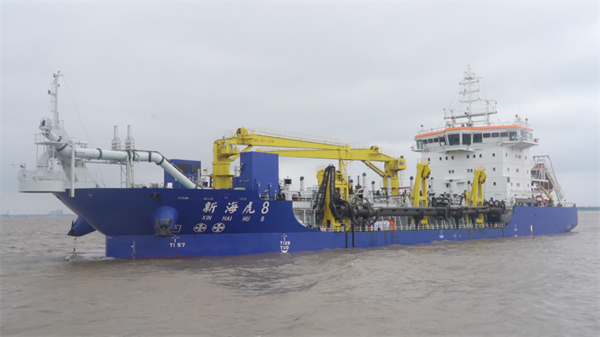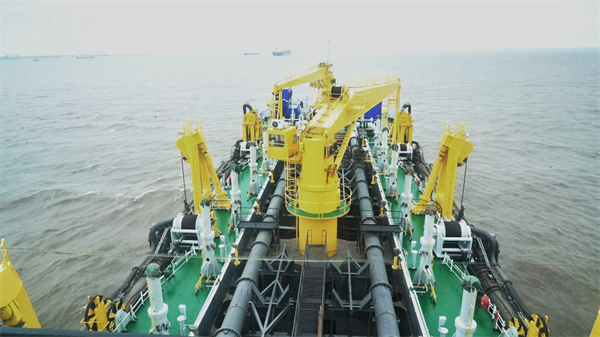China's XIN HAI HU 8 dredger, equipped with a one-click dredging intelligent system, returned to the mouth of the Yangtze River this month to ensure that the 12.5-meter-deep waterway can be maintained even during flood and sedimentation season.

The XIN HAI HU 8, a self-propelled trailing suction hopper dredger, works on the estuary of the Yangtze River on May 7. [Photo/chinadaily.com.cn]
The 130.3-meter-long XIN HAI HU 8 is a self-propelled trailing suction hopper dredger with a width of 25.6 meters and a depth of 9.2 meters. It was delivered by the Zhenhua Shipyard in Shanghai Changxing Island in 2012 to CCCC Shanghai Dredging Co., Ltd., a subsidiary of China Communications Construction Company Limited (CCCC).
Last September, the dredger was upgraded with a self-developed intelligent dredging system, said Song Jiakai, captain of the XIN HAI HU 8.

A view of the XIN HAI HU 8 in dredging operations [Photo/chinadaily.com.cn]
By simply entering the required amount of soil into the system, the dredger can execute the command automatically and will return to the platform after finishes the work, completing the entire operation with only one click.
A test at Yangshan Port showed that compared with manual dredging, the intelligent way can improve XIN HAI HU 8's overall efficiency by 10 to 20 percent, and reduce daily fuel consumption to about 35 tons, said Song.
The system also requires less labor, he added. It used to need at least 45 crew members for one dredger. But now, about 22 crew members are enough.
The XIN HAI HU 8 is the experimental mother ship. The new system will soon be installed onto other ships, such as XIN HAI NIU, XIN HAI HU and XIN HAI HU 4.
Currently a 15,000-cubic meter capacity LNG dredger built by the company is also being equipped with the intelligent system and is expected to be launched in October 2024, said Wang Xiong, electrician of the XIN HAI HU 8.
The new dredger will be the first of its kind in China and the largest in the world to adopt an LNG clean energy power system, according to CCCC Shanghai Dredging Co., Ltd.
In the future, the development of dredging will become increasingly intelligent, and adapted to more complex working conditions, said Wang, adding that the goal is to achieve completely unmanned operations, where dredgers can autonomously carry out dredging.
Meanwhile, safety and emergency response are also the focus.
Currently, a total of four 10,000 cubic meter large-scale trailing suction hopper dredgers have been involved in the construction of the deepwater channel maintenance project in the Yangtze River Estuary.
The Yangtze River estuary is an important waterway transportation hub and a global shipping mainline, with a reputation as a "golden waterway". However, it has been troubled by sedimentation. Every year's flood season in May, 480 million tons of sand, more than 60 million cubic meters, flow down from the upper reaches of the river, causing significant impact on the normal operation of Shanghai's international shipping.
Through as long as four decades of research and 13 years of dredging projects construction, the navigational depth of the Yangtze River Estuary has been increased from seven meters to 12.5 meters, making it a deepwater channel.
Previously, ships over 50,000 tons were practically unable to enter or exit the Yangtze River estuary. Now, an average of more than 13 such large ships do so each day. Furthermore, before the 12.5-meter deepwater channel opened, ships on the river with draft greater than 10 meters numbered fewer than 1 vessel per day on average. After the opening, the average rose to 30.
(Executive editor: Wang Ruoting)